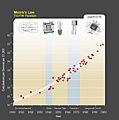Futurology facts for kids
Futurology is a cool way of saying "studying the future." It's all about trying to guess what might happen next in our world, especially with new technology and how people live together. People who study the future are called futurists. They don't have a magic crystal ball, but they use clues from the past and present to imagine different possible futures.
Contents
What is Futurology?
Futurology, also known as futures studies, is like being a detective for tomorrow. It's not about predicting one exact future, but about exploring many different ones. Futurists look at trends, ideas, and changes happening now. They then think about how these things might grow and change over time. This helps us prepare for what's ahead.
Why Study the Future?
Thinking about the future helps us make better choices today. If we understand possible challenges or exciting opportunities, we can plan for them. For example, knowing that technology is advancing quickly helps schools prepare students for future jobs. It also helps cities plan for new ways people might travel or live.
Planning for Tomorrow
Studying the future helps governments, businesses, and even regular people. It allows them to think about big questions. What will our cities look like? How will we get energy? What new inventions will change our lives? By asking these questions, we can work towards a better future for everyone.
How Do Futurists Work?
Futurists use many tools to explore the future. They look at history to see how things have changed before. They study science and technology to understand new discoveries. They also pay attention to social changes, like how people communicate or what they care about.
Looking at Trends
One important tool is looking at trends. A trend is a general direction something is going in. For example, the trend of computers getting smaller and more powerful is something futurists notice. They might then guess that in the future, computers will be even tinier or even built into our clothes. This idea is called extrapolating future trends. It means taking what we know now and stretching it into the future.
Different Futures
Futurists often think about three types of futures:
- Possible futures: These are all the things that could happen.
- Probable futures: These are the things that are most likely to happen based on current trends.
- Preferable futures: These are the futures we want to happen. Futurists help us think about how to make these good futures a reality.
Famous Futurists and Ideas
Many people have thought deeply about the future. Their ideas have shaped how we think about what's next.
Sir Thomas More and Utopia
Hundreds of years ago, a man named Sir Thomas More wrote a book called Utopia. In this book, he described a perfect island society. This idea of a "utopian" place, where everything is ideal, has made people dream about better ways to live. It encourages us to imagine what a perfect future might look like, even if it's hard to reach.
H. G. Wells and Future Studies
H. G. Wells was a famous writer who lived a long time ago. He wrote many science fiction books about time travel and aliens. In 1902, he gave a speech where he talked about the importance of studying the future in a serious way. He believed that understanding the future could help us avoid problems and build a better world.
Rachel Carson and the Environment
Rachel Carson was a scientist and writer. Her book, Silent Spring, published in 1962, warned people about the dangers of pollution. This book helped start the modern environmental movement. It showed how important it is to think about the long-term effects of our actions on the planet. Her work changed how futurists thought about the future, adding environmental health as a key topic.
Related pages
Images for kids
-
Moore's law is an example of futurology. It shows how computer power has grown over time, helping us guess future trends.
-
Sir Thomas More, who first wrote about the idea of a 'Utopia'.
-
H. G. Wells suggested studying the future in a lecture in 1902.
-
Rachel Carson, author of Silent Spring, which helped start the environmental movement.
See also
 In Spanish: Futurología para niños
In Spanish: Futurología para niños






